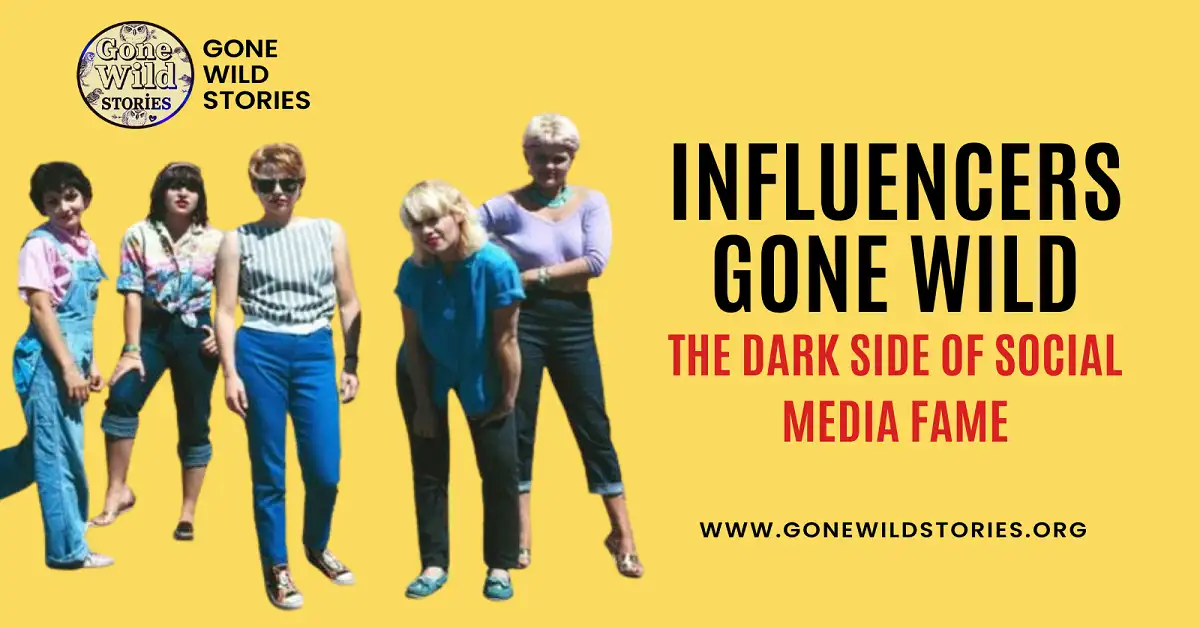Influencers Gone Wild: The Dark Side of Social Media Fame
Table of Contents
- Introduction
- The Rise of Influencer Culture
- What Does “Influencers Gone Wild” Mean?
- Scandals and Controversies of Social Media Influencers
- The Psychology Behind Influencer Behavior
- The Impact on Followers and Society
- How Brands and Platforms Respond
- Lessons to Learn from Influencer Downfalls
- Conclusion
- FAQs
Introduction
The rise of social media has given birth to a new kind of celebrity—the influencer. These individuals build a massive online following, shaping trends, promoting brands, and even influencing political or social movements. However, with great influence comes great responsibility, and not all influencers handle it well. The term “Influencers Gone Wild” has gained popularity as people witness the dark side of influencer culture—scandals, frauds, and outrageous behavior.
In this article, we’ll explore the wild world of influencers, analyzing their rise to fame, the controversies they get entangled in, and the consequences of their actions.
The Rise of Influencer Culture
Over the last decade, social media platforms like Instagram, YouTube, TikTok, and Twitter have transformed regular individuals into online celebrities. Unlike traditional celebrities, influencers gain fame through their personal branding, content creation, and engagement with followers.
With millions of people following their every move, influencers have significant power over consumer behavior, trends, and even social issues. However, the pressure to stay relevant and the pursuit of wealth and fame often lead influencers to unethical or reckless actions.
What Does “Influencers Gone Wild” Mean?
The phrase “Influencers Gone Wild” refers to social media influencers who engage in controversial, scandalous, or reckless behavior. This can range from fraud and deception to inappropriate content, public breakdowns, and even criminal activity.
While some influencers are caught in minor scandals, others completely destroy their reputations through their actions. Some incidents make headlines, while others quietly erode trust within their fanbase.
Scandals and Controversies of Social Media Influencers
Influencers often find themselves in trouble due to a variety of reasons. Let’s take a look at some of the most common controversies surrounding them.
1. Fraud and Fake Followers
One of the biggest scandals in the influencer world is the use of fake followers, likes, and engagement. Many influencers purchase fake engagement to appear more popular than they actually are.
Some brands, unaware of these fraudulent tactics, invest thousands of dollars in influencer marketing campaigns, only to receive little to no return on investment. Platforms like Instagram and Twitter have cracked down on such fraud, but it still remains a common problem.
2. The Pressure to Stay Relevant
Influencers are constantly under pressure to stay in the spotlight. Some go to extreme lengths, including staging dramatic life events, faking relationships, or stirring up controversy to remain trending.
For example, some influencers have faked mental health struggles or personal tragedies just to gain sympathy and followers. Such manipulative behavior eventually backfires when the truth comes out.
3. Offensive and Insensitive Content
Numerous influencers have faced backlash for posting offensive or culturally insensitive content. From making racist or sexist remarks to mocking social issues, influencers have landed in hot water multiple times.
For instance, influencers have been caught making inappropriate jokes about tragic events or exploiting marginalized communities for engagement. In many cases, their careers take a hit as brands distance themselves from such behavior.
4. Unethical Promotions and Scams
Many influencers make money through sponsorships and promotions. However, not all of them promote ethical or safe products.
There have been cases where influencers endorsed fake or unsafe products, misleading their followers. Some promoted cryptocurrency scams, pyramid schemes, or even harmful beauty products, resulting in massive financial and health losses for their fans.
5. Public Meltdowns and Outbursts
Some influencers have experienced dramatic public breakdowns, either due to stress, backlash, or personal issues. From live-streamed rants to public fights, these meltdowns are often shocking to fans.
While mental health struggles should be treated with empathy, some influencers have crossed the line by attacking fans, critics, or even their own colleagues. Such incidents usually lead to massive unfollowing and loss of brand deals.
The Psychology Behind Influencer Behavior
Why do influencers engage in reckless behavior? Here are some psychological reasons:
- The Fame Trap: Rapid fame can lead to a distorted sense of reality, making influencers feel untouchable.
- Validation Addiction: Many influencers crave likes, comments, and shares, pushing them to create increasingly extreme content.
- Lack of Accountability: Unlike traditional celebrities, influencers don’t always have PR teams or managers controlling their actions.
- Monetary Pressure: When sponsorship deals become their primary source of income, influencers may engage in dishonest promotions to maintain their lavish lifestyles.
The Impact on Followers and Society
Influencer scandals don’t just affect the influencers themselves—they impact millions of followers and society at large.
- Trust Issues: Scandals lead to skepticism towards influencers, making it harder for genuine creators to thrive.
- Mental Health Problems: Unrealistic portrayals of success can create self-esteem issues among followers.
- Consumer Manipulation: False advertising and scams can lead to financial loss for fans who trust their favorite influencers.
How Brands and Platforms Respond
Brands and social media platforms have started taking influencer controversies more seriously. Some ways they address the issue include:
- Cutting Ties: Brands drop influencers involved in major scandals.
- Demonetization: Platforms like YouTube demonetize problematic influencers, cutting off their income.
- Stricter Policies: Social media sites implement stricter content policies to prevent fraud and misleading promotions.
However, some brands still prioritize engagement over ethics, continuing to work with controversial figures.
Lessons to Learn from Influencer Downfalls
If there’s one thing we can learn from influencers who’ve gone wild, it’s the importance of ethics and authenticity. Some key takeaways include:
- Stay Authentic: Followers value genuine content over fake, exaggerated personas.
- Be Responsible: Influencers should think about the consequences of their actions before posting.
- Avoid Scams: Both influencers and followers should be cautious about promoting or purchasing questionable products.
Conclusion
The world of influencers is filled with both inspiration and controversy. While social media has given individuals the power to create and share, it has also led to a culture of excess, deception, and irresponsibility.
Understanding the realities behind influencer culture helps us make informed choices as followers, consumers, and content creators. Ultimately, ethical and responsible influencers will continue to thrive, while those who go wild may find their fame short-lived.
FAQs
Q1: Why do influencers get involved in controversies?
Influencers face immense pressure to stay relevant and financially successful. Some resort to unethical tactics or outrageous behavior to maintain their fame.
Q2: Do influencers face legal consequences for their actions?
Yes, depending on the severity of their actions. Fraudulent promotions, tax evasion, or defamation can lead to lawsuits and even jail time.
Q3: Can canceled influencers make a comeback?
Some influencers successfully rebrand themselves after a scandal, while others lose their credibility permanently.
Q4: How can followers differentiate between genuine and fake influencers?
Checking engagement rates, reading reviews, and researching an influencer’s past behavior can help determine their credibility.



